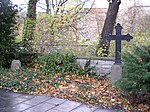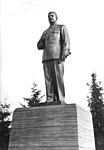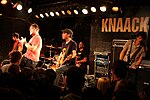Karl-Marx-Allee is a monumental socialist boulevard built by the GDR between 1952 and 1960 in Berlin Friedrichshain and Mitte. Today the boulevard is named after Karl Marx. It should not be confused with the Karl-Marx-Straße in the Neukölln district of Berlin.
The boulevard was named Stalinallee between 1949 and 1961 (previously Große Frankfurter Straße), and was a flagship building project of East Germany's reconstruction programme after World War II. It was designed by the architects Hermann Henselmann, Hartmann, Hopp, Leucht, Paulick, and Souradny to contain spacious and luxurious apartments for workers, as well as shops, restaurants, cafés, a tourist hotel, and an enormous cinema, the Kino International.
The avenue, which is 89 metres (292 ft) wide and nearly 2 kilometres (1.2 mi) long, is lined with monumental eight-story buildings designed in the wedding-cake style, the socialist classicism of the Soviet Union. At each end are dual towers at Frankfurter Tor and Strausberger Platz designed by Hermann Henselmann. The buildings differ in the revetments of the facades which contain often equally, traditional Berlin motifs by Karl Friedrich Schinkel. Most of the buildings are covered by architectural ceramics.
In 1963 the tiled facades of these buildings were falling off, necessitating sheltering structures over the sidewalks in some places to protect pedestrians.A monumental Stalin statue presented to the East German government by a Komsomol delegation on the occasion of the Third World Festival of Youth and Students was formally dedicated on 3 August 1951 after being temporarily placed at a location on the newly designed and impressive boulevard. It remained there until 1961 when it was removed in a clandestine operation in the course of de-Stalinization.
On 17 June 1953 the Stalinallee became the focus of a worker uprising which endangered the young state's existence. Builders and construction workers demonstrated against the communist government, leading to a national uprising. The rebellion was quashed with Soviet tanks and troops, resulting in the loss of at least 125 lives.
Later the street was used for East Germany's annual May Day parade, featuring thousands of soldiers along with tanks and other military vehicles to showcase the power and the glory of the communist government.
De-Stalinization led to the renaming of the street, after the founder of Marxism, in late 1961. Since the collapse of Eastern European communism in 1989/1990, renaming the street back to its prewar name Große Frankfurter Straße has periodically been discussed, so far without conclusive results.
The boulevard later found favour with postmodernists, with Philip Johnson describing it as 'true city planning on the grand scale', while Aldo Rossi called it 'Europe's last great street.' Since German reunification most of the buildings, including the two towers, have been restored.












